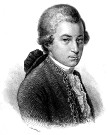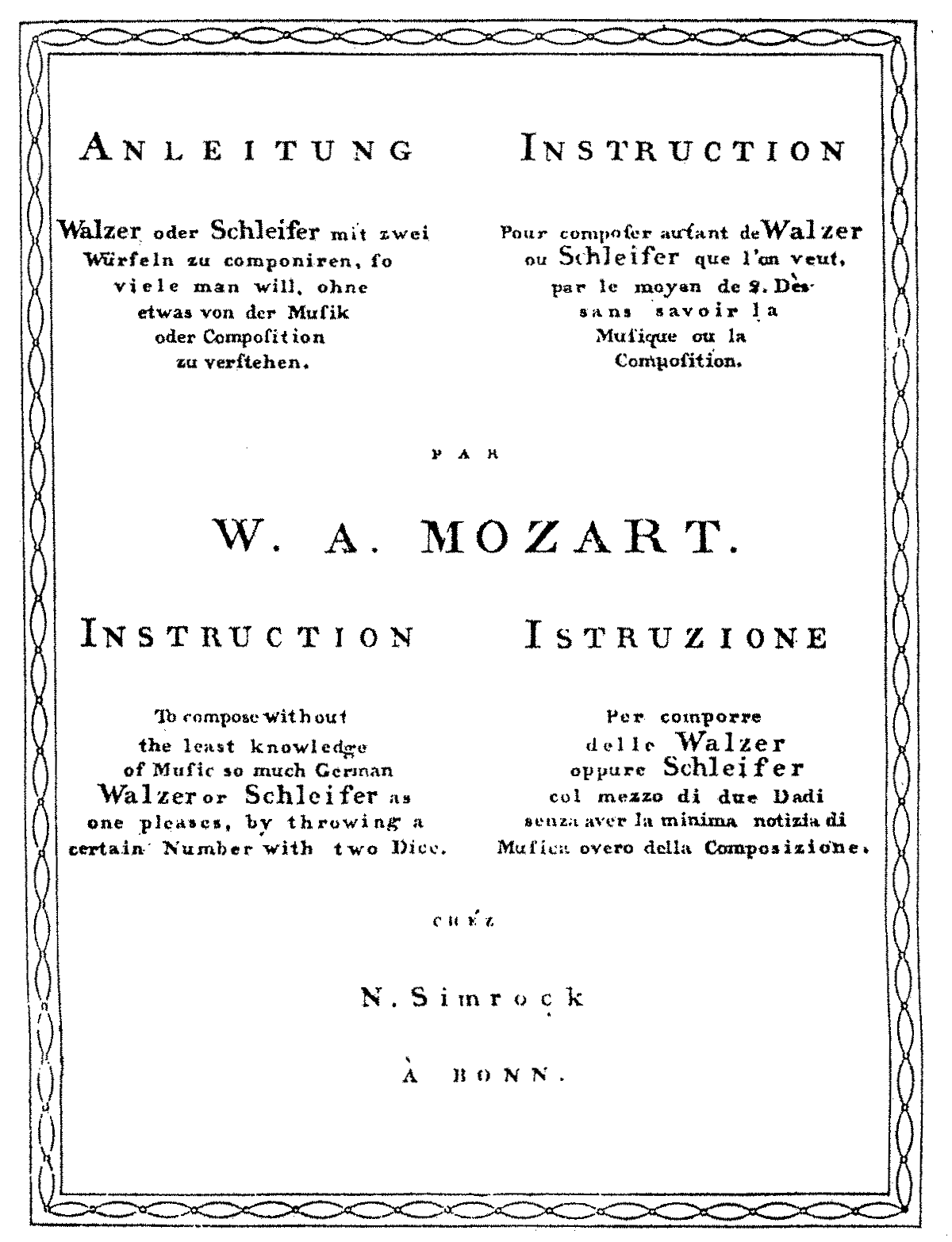
 Mozart
Mozart
Wolfgang Amadeus Mozart (1756 - 1791)

|
| The original cover for the publication "Anleitung Walzer oder Schleifer mit zwei Würfeln zu componiren, so viele man will, ohne etwas von der Musik oder Composition zu verstehen". (click to enlarge) |
Mozart loved games. His playing with words in his letters (a.o. in the "Bäsle-letters" to his niece, Bunge, 1977), or in his music (as in "Ein musikalischer Spass", KV 522), made clear that he chose the sunny side of life, wherever possible. His "Musikalisches Würfelspiel" fits that pattern well.
In 1787, during his first visit to Prague, he wrote the opera "Don Giovanni", but he also spent some time in writing a parlor game. It was probably a nice interruption for him during this busy period of giving concerts and working on new compositions.
The main proof for Mozart's activities in this field is the authentic sketch sheet of a string quartet (KV 516 ), which, in addition to a part of the Adagio of this quartet, contains several systems with loose measures (KV 516f) (Robbins Landon, 1990). KV 516f might have been written between 16 May 1787 (date of K. 516) and 28 October 1787 (date of KV 527 in Mozart's own "Verzeichnis aller meiner Werke").
It is a game in which, for each two measures, a letter is assigned in such a way that through the combination of those letter-measures any name or word in any length can be transformed into music. The mechanisms of this game were decrypted by Hideo Noguchi in 1990. After analyzing the meaning of the alphabetic letters in Mozart's manuscript, it was concluded that there is evidence that he wrote this dice game for Francisca von Jacquin, a talented piano student of his (Noguchi, 1990).
The Waltz
The famous Waltz dice game we used here was not published until after his death by Hummel in Berlin in 1793. Since the authorship of the manuscript is not fully revealed, it has been considered up to now as Mozart's Musical Dice Game. Our implementation of the game is based on a reprint, published by Simrock in Bonn in 1796 and titled: "Anleitung Walzer oder Schleifer mit zwei Würfeln zu componiren, so viele man will, ohne etwas von der Musik oder Composition zu verstehen".
Several other kinds of musical dice games were spuriously published under the name of Mozart. Although the idea was not new and had been applied by other composers before Mozart, it was Mozart's game which became famous and successful.
The waltz game, as published by Simrock, has 17 measures: two 8-measure sections plus a 2nd ending measure for the A section. The first and second endings of the A section are always the same. For some reason, Mozart wrote only two alternatives for the final measure. For each of the other 14 measures he wrote 11 alternatives; 11 because that's how many different sums you can get by tossing two dice (from 2 to 12). So, in total, Mozart wrote 11 x 14 + 2 = 156 measures for the Musikalisches Würfelspiel, although the publication contains all the "doubles" as well, adding up to 176 measures (see: "Measures").
The harmonic structure for the first 8-measure section follows the pattern C / C / G / C / D7 / G / C.D / G/; for the second section, the structure is: D / G / C / G / C / C / F.G / C/.
The Contredanse
Around 1793, i.e. after Mozart's death, J.J. Hummel in Berlin-Amsterdam published in four languages "Anleitung, mit zwei Würfeln sowohl Walzer und Schleifer wie Contretänze zu komponieren." (Instructions, with two dice for both waltzes and Schleifer as well as contra dances to compose.) The contredanse as known in the Netherlands and France since around 1685, equals the country dance, adopted from England. It was equally popular at court and middle class in the 18th century. The dance was of great importance on the French stage between 1710 to around 1760 and was particularly used by Rameau.
The contra dances come second in Mozart's dances, after the menuets. In addition to the pure dance pieces, Mozart also incorporated dance-like parts into other contexts. At the same time, Mozart wrote numerous contra dances for practical use between 1776 and 1788, so it should not be surprising that Mozart has also dealt with contra dance in the field of dice game music.
The present dice game, attributed to Wolfgang Amadeus Mozart, can be played in all conceivable bar combinations, based on a uniform key plan, similar to the Waltz dice game. One can imagine this musical dice game as a letter case in whose empty compartments individual objects are placed. The model interpretation requires one abstract and formulaic view of music. That the music is formulaic, is shown, among other things, by the fact that Mozart's other dice game is based on exactly the same formal plan and approximately the same key plan. Finally, it must be noted that in the instructions on composing English contra dances, there are a lot of false progressions and technical errors, so that the quality of the game cannot be rated as high as the instructions for composing waltzes.
The harmonic structure for the first 8-measure section follows the pattern C / C / G7 / C / D / G / C / D7,G/; for the second section, the structure is: D / G / C / G / C / C / G7 / C/.
Sources- Bunge, L. (1977), Mozart in zijn brieven (Mozart in his letters), Utrecht, Bohn, Scheltema & Holkema.
- Mozart, W.A. (1796), Anleitung Walzer oder Schleifer mit zwei Würfeln zu componiren, so viele man will, ohne etwas von der Musik oder Composition zu verstehen, Bonn, Simrock.
- Noguchi, H. (1990), Mozart - Musical Game in C K. 516, in: " Mitteilungen der ISM, 38, Heft 1-4", p. 89-101. See also: http://www.asahi-net.or.jp/~rb5h-ngc/e/k516f.htm
- Robbins Landon, H.C., ed. (1990), The Mozart Compendium, London, Thames and Hudson.